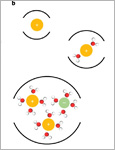The capacitance of the electrochemical interface has traditionally been separated into two distinct types: non-Faradaic electric double-layer capacitance, which involves charge induction, and Faradaic pseudocapacitance, which involves charge transfer. However, the electrochemical interface in most energy technologies is not planar but involves porous and layered materials that offer varying degrees of electrolyte confinement. We suggest that understanding electrosorption under confinement in porous and layered materials requires a more nuanced view of the capacitive mechanism than that at a planar interface. In particular, we consider the crucial role of the electrolyte confinement in these systems to reconcile different viewpoints on electrochemical capacitance. We propose that there is a continuum between double-layer capacitance and Faradaic intercalation that is dependent on the specific confinement microenvironment. We also discuss open questions regarding electrochemical capacitance in porous and layered materials and how these lead to opportunities for future energy technologies.

